10 Common Types of Sparrows in Texas (With Pictures)
Last Updated on
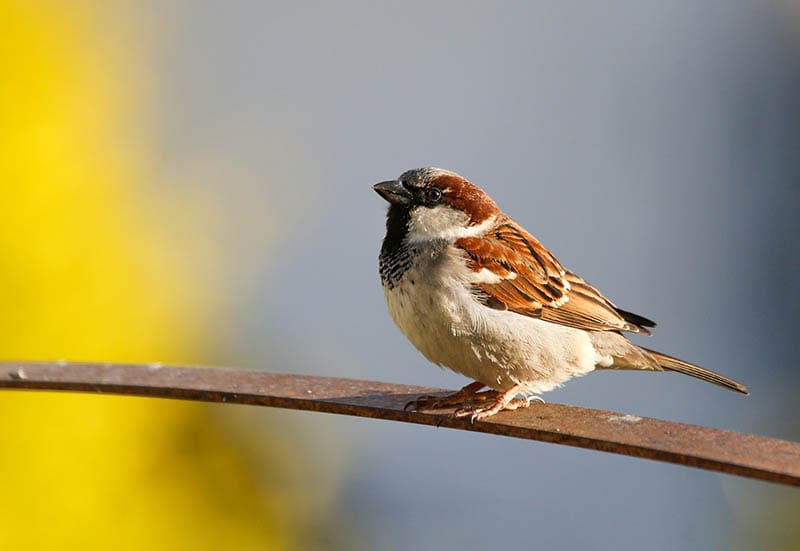
There’s a very high probability that you’ve seen a sparrow if you’ve ever lived on the North American continent. And we’re almost 100% certain because these birds seem to be everywhere. Most of them are part of the Passeridae family, but some fall under Emberizidae.
There are about 140 different species in the sparrow community. However, if you narrow your geographic location and focus only on North America, you’ll only find 35 species.
They do have traits that define them as individuals, and also as a family. We’re here to talk about some of the unique individual features, but one of the general attributes is the fact that they are relatively small.

The 10 Most Common Texan Sparrows
1. House Sparrow

| Weight: | 0.9 – 1.1 oz (27 – 30 g) |
| Length: | 5.9 – 6.7 in (15 – 17 cm) |
| Wingspan: | 7.5 – 9.8 in (19 – 25 cm) |
Scientifically, this species is known as the Passer Domesticus. And as expected, it’s a very small bird, with nearly all the features that define the sparrow. The house species was introduced to us by the Brooklyn Institute in 1850. They were shipped from England, acclimatized over winter, and finally released in Brooklyn, New York.
The males look like they are wearing a black bib and gray crown, and have largely brown backs. The female plumage is not so very different, since it’s also notably brown, albeit dull. When trying to distinguish this species from the rest, we usually look for the tan line that always extends behind the eye.
The house sparrow is invasive in nature. They like to fight to the seemingly limited nest cavities with other species, including the Purple Martins and Bluebirds. You don’t have to visit any forest if you’d like to see them interact in their natural habitats. Just pop your head outside your window and follow their sounds. They love living close to humans.
2. Swamp Sparrow

| Weight: | 0.5 – 0.8 oz (15 – 23 g) |
| Length: | 4.7 – 5.9 in (12 – 15 cm) |
| Wingspan: | 7.1 – 7.5 in (18 – 19 cm) |
The Melospiza Georgiana is a mid-sized sparrow, and that’s one of the things that make it unique. Well, that and the fact that they have a comparatively long tail, conical bill, and generally appear plump. Telling apart the males from the females is not going to be a cakewalk, as both sexes come with gray faces, breasts, and throats. Their wings are also reddish-brown.
Apparently, the easy way to detect or identify one is by listening to their calls. The sounds they produce cannot be imitated by other sparrows in their family—not even close.
The best time to look for a swamp sparrow in Texas is during summer. Chances are you’ll find them perched close to the water’s edge, or busy foraging for seeds. If they are not in the mood for the vitamins and monounsaturated fats found in seeds, they’ll be hunting insects, hoping to hit the target for their daily recommended protein intake.
We came to learn that their long legs are the reason why they catch prey in shallow waters with ease. They’ll only visit your yard if you have blueberries, lilies, and a thick ground cover that acts as concealment.
3. White-Crowned Sparrow

| Weight: | 0.9 – 1.0 oz (25 – 28 g) |
| Length: | 5.9 – 6.3 in (15 – 16 cm) |
| Wingspan: | 8.3 – 9.4 in (21 – 24 cm) |
The Zonotrichia Leucophrys has a head that’s peaked on its crown. And yes, they are actually called “white-crowned” because that whole head is predominately white, with a few stripes of black. This is yet another species that are difficult to distinguish the males from the females. You’ll have to be an expert to nail it.
Both have beaks that are either pinkish or orangish-yellow and plumage that’s brownish or grayish. Their preferred habitats are described as shrubbery, but when it’s time to breed they’ll move to the open grasslands.
The one thing that makes this particular species special is its ability to travel long distances. They are capable of covering approximately 300 miles in a single night—some even more.
4. Savannah Sparrow
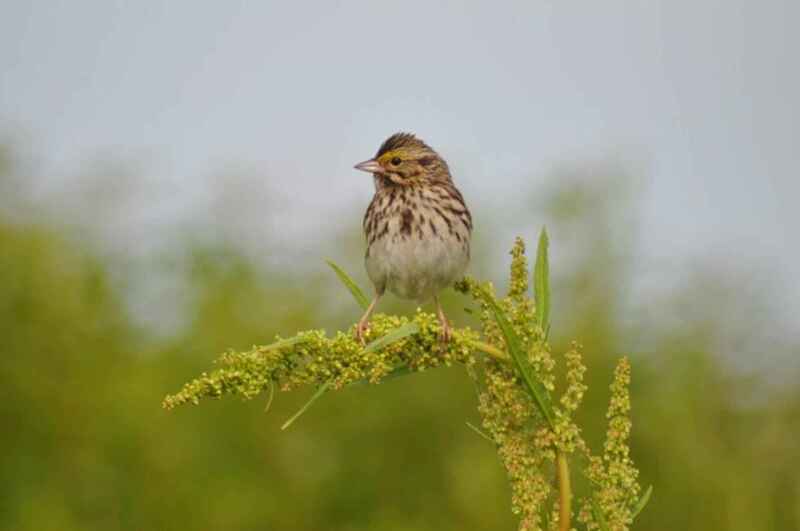
| Weight: | 0.5–1.0 oz (15–28 g) |
| Length: | 4.3–5.9 in (11–15 cm) |
| Wingspan: | 7.9–8.7 in (20–22 cm) |
The Passerculus Sandwichensis is tiny—and really looks delicate as well. The male and female plumages are brown in color, and the tails are short. They always seem to have a yellow mark right above their eyes, and that’s how we usually differentiate them from their cousins.
Speaking of relatives, compared to other species, it’s safe to say they are the most widespread. It’s quite easy to find a savannah foraging for food in agricultural fields, in the parks, next to shopping centers, along the grassy roadside, and in several other places. Sadly though, they don’t like visiting bird feeders.
The good news is, because they really hate the cold, and know humans often build homes that provide warmth, they normally show up once the temperatures start dropping. So, if you live by a field, and you happen to have a brush pile just next to your house, expect some visitors soon.
5. Snow Bunting

| Weight: | 1.1–1.6 oz (31–46 g) |
| Length: | 5.9 in (15 cm) |
| Wingspan: | 11.8 in (30 cm) |
All this talk about winter reminded us of the Plectrophenax Nivalis. This species is sometimes referred to as the snowflake, simply because it sort of looks like it while swirling through the air. Funny thing is, while other species are busy migrating during winter, running away from the cold, the snow bunting runs towards it. They are strictly winter birds that usually suffer when the temperatures start rising.
The snow bunting will come to say hi during winter (every season), and then travel back home. They are mainly found in the arctic, where they have built beautiful homes. It’s not easy to spot a bunting nest, as they are normally constructed in the deep cracks of huge rocks. That’s how they manage to protect their eggs from the cold winds.
While the mom incubates the eggs, the dad hunts for spiders, insects, or any invertebrate that looks delicious. He’ll then take the food back to the nest and feed his partner every 15 minutes or so.
Even though snow buntings are very rare in some parts of the world, they still have a “Least Concern” tag as their conservation status. Meaning, experts have studied their populations, including that of the breeding community, and concluded that they are just concentrated in some areas more than others.
6. Lark Sparrow

| Weight: | 0.8 – 1.2 oz (24 – 33 g) |
| Length: | 5.9 – 6.7 in (15 – 17 cm) |
| Wingspan: | 11.0 in (28 cm) |
The Chondestes Grammacus is more common during winter than it is during summer. They do have very distinctive features, as you’ll note the brown-streaked back and striped crown. Everything else is typical of a sparrow, including the size.
These birds love hanging out in the open grounds, and this provides an incredible opportunity to hunt beetles, caterpillars, bugs, and so many other insects. If they wish to go green for a while, they’ll forage for weeds, seeds, and sometimes grass.
There are no gender-specific roles in this community, seeing as both the males and females share equal responsibility of making sure that the nest’s ready for breeding commences. The men often supply the materials while the women do the actual construction.
The nest can be anywhere, as long as it’s well concealed from predators and harsh weather elements. So, they’ll construct it in the crevices of rocky cliffs, low-lying branches of trees, or on the ground. The exterior will be built using twigs, and the interior using fur, weeds, or soft grass.
7. Olive Sparrow
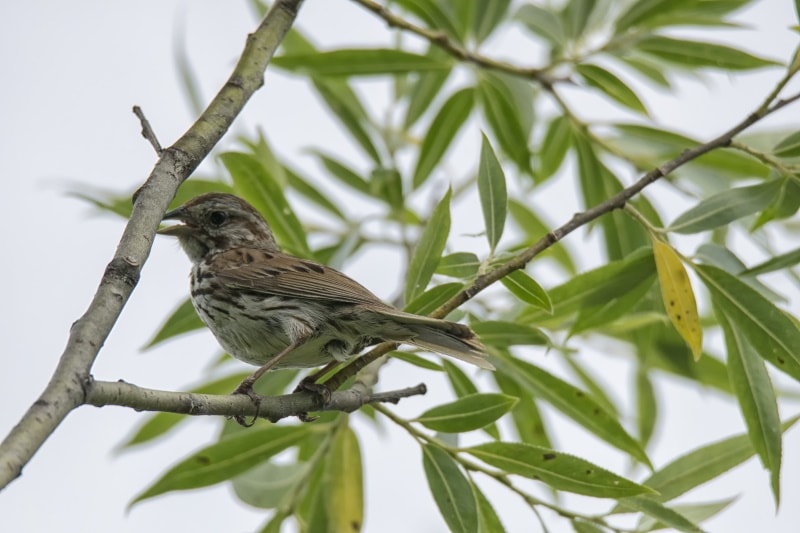
| Weight: | 0.5–1.1 oz (15–30 g) |
| Length: | 5.3–5.9 in (13.5–15 cm) |
| Wingspan: | .9 in (20 cm) |
The Arremonops Refivirgatus is a non-migratory species, and that’s why you get to see it in Texas all year round—especially in the southern parts, where the conditions are a little bit more favorable. Our birding community and experts prefer the name “olive sparrows” because their backs are dark yellowish-green, just like an olive.
It’s important to take note of the fact that an olive sparrow that’s bred in the pacific might have features that are slightly different from our olives. According to scientists, environmental differences do play a pivotal role in triggering evolution. If they fail to adapt, they end up dying.
But the one thing that never changes is how similar the males and females look. Even if they evolve, both sexes will still have the same appearance. Save for the juveniles, of course. They tend to be browner, with fewer streaks.
The streaks are meant to provide sufficient camouflage. These birds have many enemies who can’t wait to make a meal out of them. We’re talking about snakes, owls, eagles, and even hawks. It’s not easy spotting them in their natural habitats, though, which are often described as densely vegetated.
They like to forage for insects and seeds in pairs, hopping from one bush to the next. their tails are always up for some reason.
8. Bachman’s Sparrow
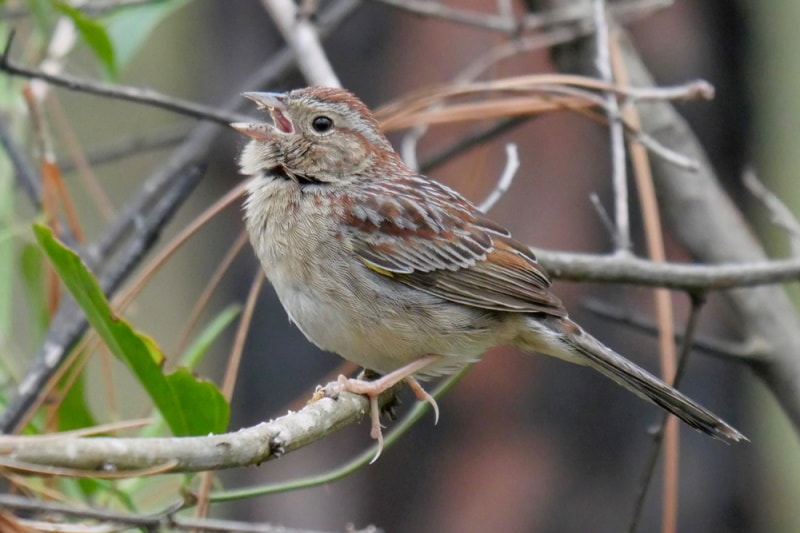
| Weight: | 0.6 – 0.8 oz (18 – 22 g) |
| Length: | 4.9 – 6.0 in (12.4 – 15.2 cm) |
| Wingspan: | 7.2 in (18.4 cm) |
In Texas, the Peucaea Aestivalis has been tagged as “near-threatened.” They are common in some parts, but very rare in other parts. Also, if you compare their population size now with what we registered a few years back, you’ll learn that it’s rapidly reducing.
Our bachman friend is a mid-sized species, with a brown back and head. Its principal distinguishable feature is the dark reddish-brown line that usually appears from the back of the eye. Both the adult bachman have white chests, but that of the juvenile is yellowish.
We wouldn’t say the bachman is a migratory species since they only move a couple of miles away during winter. And not even all of them move. Some remain behind and go about their business as though everything’s normal. They really love spending their time in oak and pine forests, but unfortunately, such habitats are rare nowadays, as most of them have been consumed by fire.
Insects are their favorite delicacies, but they won’t mind being fed pine seeds and blueberries from time to time.
9. Black-Throated Sparrow
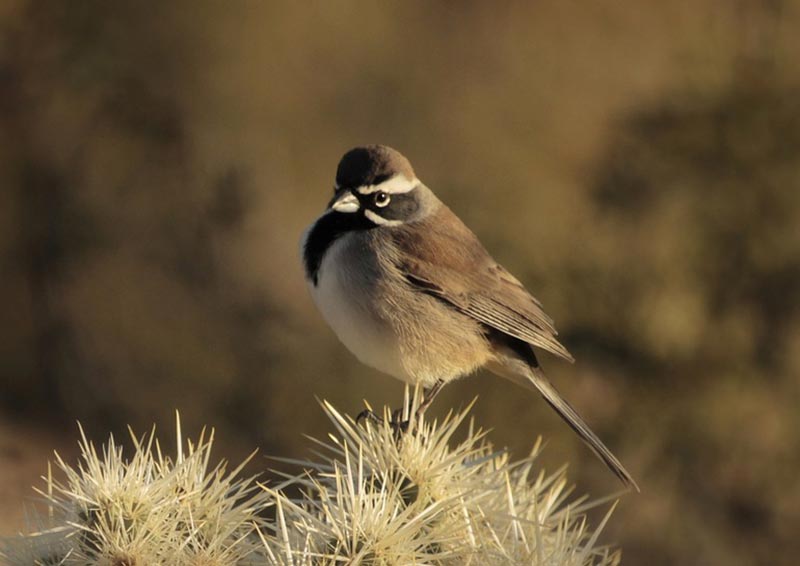
| Weight: | 0.4 – 0.5 oz (11 – 15 g) |
| Length: | 4.7 – 5.5 in (12 – 14 cm) |
| Wingspan: | 7.7 in (19.5 cm) |
There’s no denying that the Amphispiza Bilineata is the most easily recognizable species in this family. Even with a pair of binoculars that black throat and gray head will confirm you’re looking at a black-throated sparrow. Their backs are all grayish-brown, but their bellies are pale.
This one is a partial nomad. Those that live here in Texas don’t usually migrate, but those found in the northern states tend to migrate a lot. Mostly when they feel ready to start breeding.
The black-throat will devour any insect that it crosses its path with during summer, and forage for seeds in the cold season. They mostly live in the canyons, or next to the desert scrubs. That’s why their nests are often made using desert plant material, in addition to animal fur and grass.
The female black-throat can lay up to five eggs if the conditions are right. She’ll incubate them for 10 to 14 days, and then provide essential care to the hatchlings for at least a week. They always feed their young ones various insects, because that’s how they stay hydrated. In retrospect, it’s very unusual to find a black-throat sparrow drinking water.
10. Grasshopper Sparrow
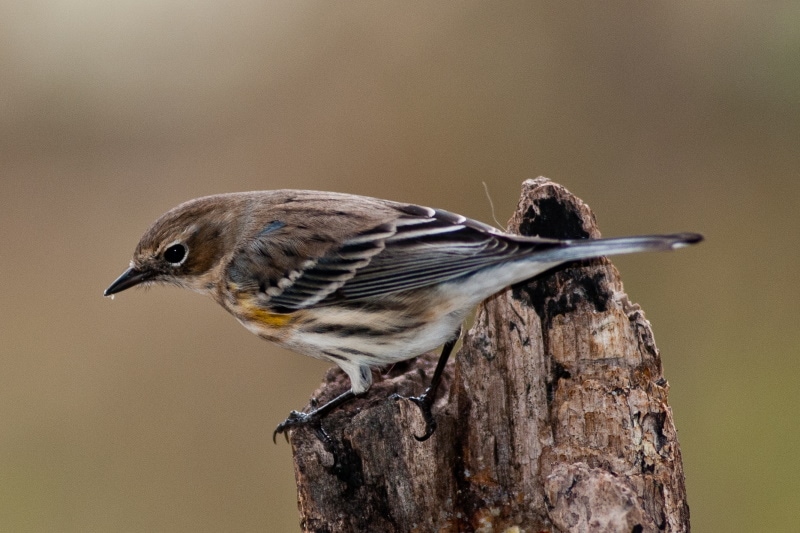
| Weight: | 0.5–0.7 oz (14–20 g) |
| Length: | 4.3–4.5 in (10.8–11.5 cm) |
| Wingspan: | 7.9 in (20 cm) |
The Ammodramus Savanarum lives here all year round. But they are so widespread that you’ll find some in the Caribbeans, Mexico, Canada, and even the UK. Regardless of the region, they will always have large beaks, short tails, pale bellies, and a yellowish-orange stripe over the eye.
The odds of finding a grasshopper sparrow hunting grasshopper on prairies are very high. Especially if you’re birding very early in the morning, or late in the evening. Nonetheless, grasshoppers are not all they eat. They’ve also been known to hunt spiders, bugs, beetles, you name them.
Seeing as it’s not easy to find insects roaming about during winter, they’ll settle for seeds. They won’t pluck them from the crop but forage the ones that have already fallen on the ground.
The grasshopper sparrow nest will be hidden somewhere on the ground, in thick vegetation. Spotting one won’t be as easy as you’d think since they are made of the same grass and plant material that grows in that area.
The female will lay five to seven eggs, incubate them for close to 2 weeks or more, and then feed while protecting the younglings for another week, as they fledge. The babies are usually fed grasshopper legs, hence the reason why you’ll find the mother violently shaking its prey until the legs fall off.

How To Attract Sparrows in Texas

A yard is not just a bird’s playground, but a potential nesting site as well. Therefore, they’ll want to have easy access to some (if not all) of the basic items required for survival. Unlike other animals, this species is not high maintenance.
Food: Generally, the sparrows are classified as granivores. That means the different varieties of grains and seeds are a staple in this community. Of course, you could buy them if you don’t mind, but we find planting seed-bearing flowers a much cheaper alternative.
Water: One of the observations that we’ve made over the years is the fact that birds love taking ground baths. Even if they have easier access to elevated water sources, they’ll still fly several miles to the closest groundwater source. So, buy a water wiggler bird bath, if you don’t have one, and install it under a tree.
Shelter: It’s obvious that these birds are smaller than your average bird. We’ve said it before, but we’ll say it again. Things work differently in the animal kingdom in the sense that bigger animals are more revered compared to smaller species. The sparrows know that, and that’s why they are always skittish. They won’t stay long in your yard if they feel exposed to various predators. If your space doesn’t have any thick shrubbery, start planting one now.
Nesting sites: The thickets are an ideal nesting site, but this bird won’t mind nesting in a birdhouse if there’s a vacancy to be filled. Also, don’t forget to provide some nesting materials, including soft grass, twigs, cotton (if you can’t access animal fur), etc.

Final Thoughts
Attracting different sparrow species to your backyard won’t be that easy. But don’t throw in the towel after a couple of tries. Once they start congregating at your feeders, you’ll realize the rewards are worth it. We also love how they seem to attract other bird species to the yard the minute they show up. Sadly though, the hawks and eagles are one of those birds.
Anyway, if you’d like to learn more about other species, kindly let us know. Your feedback is the reason we keep doing what we do.
Featured Image Credit: Kurt Bouda, Pixabay
About the Author Robert Sparks
Robert’s obsession with all things optical started early in life, when his optician father would bring home prototypes for Robert to play with. Nowadays, Robert is dedicated to helping others find the right optics for their needs. His hobbies include astronomy, astrophysics, and model building. Originally from Newark, NJ, he resides in Santa Fe, New Mexico, where the nighttime skies are filled with glittering stars.
Related Articles:
Monocular vs Telescope: Differences Explained (With Pictures)
10 Types of Hummingbirds in Arkansas (With Pictures)
8 Types of Hummingbirds in Nebraska (With Pictures)
5 Types of Hummingbirds in Idaho (With Pictures)
3 Types of Hummingbirds in Mississippi (With Pictures)
8 Types of Hummingbirds in Kansas (With Pictures)
5 Types of Hummingbirds in West Virginia (With Pictures)
5 Types of Hummingbirds in Ohio (With Pictures)
